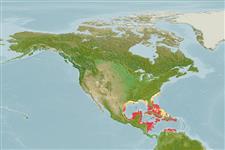ກຸ່ມປາກະດູກອ່ອນ (ເຊັ່ນ: ປາສະຫລາມ, ປາຜາໄລ) (sharks and rays) >
Myliobatiformes (Stingrays) >
Urotrygonidae (American round stingrays)
Etymology: Urobatis: Greek,oura = tail + Greek, batis, batidos = a ray (Raja sp.) (Ref. 45335).
More on author: Cuvier.
Environment: milieu / climate zone / depth range / distribution range
ນິເວດວິທະຍາ
ສັດທະເລ ກ່ຽວກັນຫີນ; ລະດັບຄວາມເລິກ 1 - 25 m (Ref. 9710). Tropical; 37°N - 7°N, 100°W - 59°W (Ref. 55316)
Western Atlantic: North Carolina, USA to northern South America. Also in Bahamas, Yucatan and throughout Caribbean (Ref. 26938).
ຂະໜາດ / ນ້ຳໜັກ / Age
Maturity: Lm ? range ? - ? cm
Max length : 76.0 cm TL ຕົວຜູ້/ບໍ່ມີເພດ; (Ref. 9710)
Short description
ສະລີລະວິທະຍາ | ການວັດແທກຮູບຮ່າງລັກສະນະພາຍນອກຂອງດິນ,ສັດ,ປາ…
Edge of disk no sharp angles, no dorsal fin. Well-developed caudal fin extends around tip of tail, doubly serrate spine near caudal fin base (Ref. 26938). Disk yellowish, with dark vermiculations and spots that form a variety of patterns on upper surface (Ref. 7251). Lower surface is yellowish, greenish or brownish white, tail with dark spots (Ref.6902).
Commonly found along sandy beaches to the water's edge, and especially in sandy areas in and around coral reefs (Ref. 7251). Raises front end of disc to attract prey seeking shelter (Ref. 7251). Feeds on shrimps, probably also on small fishes, clams, and worms (Ref. 12951). Known to be capable of inflicting dangerous wounds with its venomous spine. Easily approached (Ref. 9710). A live-bearing species, produces 3 to 4 young (Ref. 26938).
Life cycle and mating behavior
ການຈະເລີນເຕັມໄວ | ການສືບພັນ | ການວາງໄຂ່ | ໄຂ່ | ຄວາມດົກຂອງໄຂ່ປາ | ຕົວອ່ອນ
Male grasps disc margin of female, swings under her and inserts a clasper. Mating pair is surrounded by other males that swim around and nudge them. Dugger (1987) (Ref. 51118) observed both male and female biting the pectoral fin of its mate (Ref. 49562).
Compagno, L.J.V., 1999. Checklist of living elasmobranchs. p. 471-498. In W.C. Hamlett (ed.) Sharks, skates, and rays: the biology of elasmobranch fishes. Johns Hopkins University Press, Maryland. (Ref. 35766)
IUCN Red List Status (Ref. 130435)
Threat to humans
Venomous
Human uses
ຕູ້ປາ: ບ່ອນວາງສະແດງສັນນ້ຳຂອງລັດ
ຂໍ້ມູນຕື່ມອີກ
Age/Sizeການເຕີບໃຫຍ່Length-weightLength-lengthLength-frequenciesການວັດແທກຮູບຮ່າງລັກສະນະພາຍນອກຂອງດິນ,ສັດ,ປາ…ສະລີລະວິທະຍາຕົວອ່ອນການປ່ຽນແປງຂອງຕົວອ່ອນການທົດແທນທີ່ຄວາມອຸດົມສົມບູນBRUVS
ເອກະສານອ້າງອີງການລ້ຽງສັດນ້ຳຂໍ້ມູນການລ້ຽງສັດນ້ຳສາຍພັນກຳມະພັນElectrophoresesການຖ່າຍທອດທາງກຳມະພັນຈາກພໍ່ແມ່ຫາລູກພະຍາດການປຸງແຕ່ງNutrientsMass conversion
ຜູ້ຮ່ວມມືຮູບStamps, Coins Misc.ສຽງຫອຍມີພິດຊະນິດນຶ່ງທີ່ອາໄສໃນທະເລຄວາມໄວປະເພດການລອຍເນື້ອທີ່ເຫືອກOtolithsສະໝອງວິໄສທັດ
ເຄື່ອງມື
Special reports
Download XML
ແຫຼ່ງອີນເຕີເນັດ
Estimates based on models
Preferred temperature (Ref.
123201): 25.8 - 28.1, mean 27.3 °C (based on 482 cells).
Phylogenetic diversity index (Ref.
82804): PD
50 = 0.5078 [Uniqueness, from 0.5 = low to 2.0 = high].
Bayesian length-weight: a=0.01072 (0.00570 - 0.02016), b=3.03 (2.86 - 3.20), in cm total length, based on LWR estimates for this species & (Sub)family-body (Ref.
93245).
ຊັ້ນເຂດຮ້ອນ (Ref.
69278): 3.6 ±0.51 se; based on food items.
ຄວາມຢືດຢຸ່ນ (Ref.
120179): ຕຳ່ຫຼາຍ, ປະຊາກອນຕຳ່ສຸດທີ່ໃຊ້ເວລາສອງເທົ່າຫຼາຍກວ່າ 14 ປີ (Preliminary K or Fecundity.).
Fishing Vulnerability (Ref.
59153): Moderate to high vulnerability (50 of 100).
Nutrients (Ref.
124155): Calcium = 7.17 [0.77, 112.55] mg/100g; Iron = 0.376 [0.030, 3.868] mg/100g; Protein = 20.4 [15.0, 25.6] %; Omega3 = 0.069 [0.021, 0.205] g/100g; Selenium = 24.1 [4.1, 110.7] μg/100g; VitaminA = 47.1 [3.2, 591.0] μg/100g; Zinc = 0.963 [0.062, 10.956] mg/100g (wet weight);
